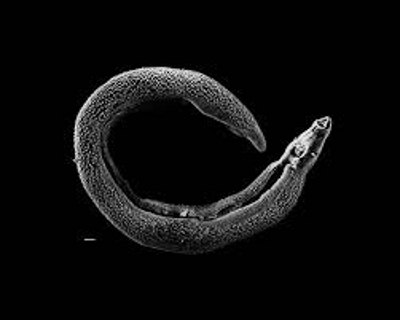It looks like you're using an Ad Blocker.
Please white-list or disable AboveTopSecret.com in your ad-blocking tool.
Thank you.
Some features of ATS will be disabled while you continue to use an ad-blocker.
share:
Okay one final thing in terms of the microscopy question.
The ancient Egyptians had worms. I know, it's hard to imagine them like that, but even Egyptian royalty was loaded with Schistosomiasis.
They were plagued by the little boogers and their medical texts reflect their struggle with the tiny invaders.
You'd think that if they had microscopes that the worms would be the first thing that they would point them at. The adults are large enough to see with the naked eye, But the microscopic eggs which are incubated by water snails in the Nile are much larger than sperm and would be a good candidate for being visualized by some ancient system of lenses.
They would have solved that problem if they had had any sort of microscopy at all.
The ancient Egyptians had worms. I know, it's hard to imagine them like that, but even Egyptian royalty was loaded with Schistosomiasis.
They were plagued by the little boogers and their medical texts reflect their struggle with the tiny invaders.
You'd think that if they had microscopes that the worms would be the first thing that they would point them at. The adults are large enough to see with the naked eye, But the microscopic eggs which are incubated by water snails in the Nile are much larger than sperm and would be a good candidate for being visualized by some ancient system of lenses.
They would have solved that problem if they had had any sort of microscopy at all.
Electron micrograph of an adult male Schistosoma parasite worm. The bar (bottom left) represents a length of 500 μm.
edit on 23-3-2014 by Bybyots because: . : .
Bybyots
Hey ya know what?
It's a flail. Usually the gods of ancient Aegypt and pharaohs are shown with both crook and flail, but Min is shown just with his flail. I pulled the detail from another Min stele so that the beaded lengths of hide can be seen more easily.
Yeah, well, in my defence I was working from illustrations from my copy of 'Description De L'Egypt' which are only an inch by a two to three inches. And I should have been wearing my reading glasses when doing so. Your detail though, makes it all very much clearer. Cheers for the correction and clarification.
Bybyots
ETA: Oh wow! Why is the flail sort of hovering there. Has Min suspended the activity of the flail by pouring out the waters of life?
I had a feeling that these steles might represent some seasonal celebration in the fall of the year because they all seem to show hieroglyphs related to enumeration and others that seem related to full jars of water and full baskets of food.
So it's fall, Min pours out, the flail is suspended?
Just had a glance through...it is always suspended when attached to a deity. Priests and Pharoahs clearly grasp it, but with the deities it just hovers over the open palm. Interesting. Obviously Amun-Min is central to both the rising of the flood waters (Opet Festival) and the harvest festivities, so partying still applies. There are some really fabulous stele at Denderah which depict, in a line, what is possibly a priest, preceded by Horus, Amun-Min, and Amun-Ra, all in the act of masturbating, and all suspending the flail above their heads. In the same room, the 'soul' bird, flies over the reclining Pharoah's (I think it is the Pharoah) erect penis. It's talons hovering dangerously close.
Given that the creation myth, with Amun as the father of the gods, involves masturbation, I presume there is some aspect of the male soul being transmitted in such a way. Or something along those lines. Very interesting though. I'm wondering about the 'drive' aspect. I'll think on that.
reply to post by KilgoreTrout
Oh geez, I couldn't tell what it was either until I dug in to it. I was hoping for the compass and all I got was that lousy flail.
Oh geez, I couldn't tell what it was either until I dug in to it. I was hoping for the compass and all I got was that lousy flail.
This is primarily for Syfloating but also to the thread generally,
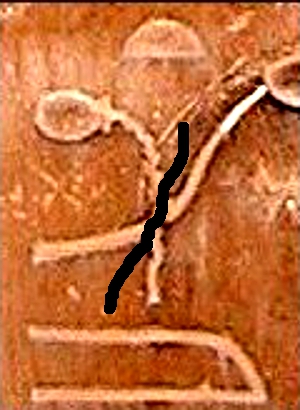
So, can we safely say that the ancient Egyptians had no form of microscopy?
The microscopy thing is really moot because we know that the glyph was never a sperm in the first place but a jar pouring water.
As for Min's issuance making contact with the glyph, we can see our way through to how that makes sense now; I find it very easy to accept that his issuance would be making contact with the issuance of the jar.
So I'll split the difference with you here in the final analysis: the the part of Min's issuance that passes the stream from the jar to the left was not intended to be part of the original stonework and is likely the result of some form of vandalism.
But, was the vandalism meaningful? Is it graffiti that has an intended meaning? What does it mean that Min's issuance does not merge with the outflowing of the water of life any longer but cut's it?

So, can we safely say that the ancient Egyptians had no form of microscopy?
The microscopy thing is really moot because we know that the glyph was never a sperm in the first place but a jar pouring water.
As for Min's issuance making contact with the glyph, we can see our way through to how that makes sense now; I find it very easy to accept that his issuance would be making contact with the issuance of the jar.
So I'll split the difference with you here in the final analysis: the the part of Min's issuance that passes the stream from the jar to the left was not intended to be part of the original stonework and is likely the result of some form of vandalism.
But, was the vandalism meaningful? Is it graffiti that has an intended meaning? What does it mean that Min's issuance does not merge with the outflowing of the water of life any longer but cut's it?
Bybyots
Okay one final thing in terms of the microscopy question.
The ancient Egyptians had worms. I know, it's hard to imagine them like that, but even Egyptian royalty was loaded with Schistosomiasis.
They were plagued by the little boogers and their medical texts reflect their struggle with the tiny invaders.
You'd think that if they had microscopes that the worms would be the first thing that they would point them at. The adults are large enough to see with the naked eye, But the microscopic eggs which are incubated by water snails in the Nile are much larger than sperm and would be a good candidate for being visualized by some ancient system of lenses.
They would have solved that problem if they had had any sort of microscopy at all.
Electron micrograph of an adult male Schistosoma parasite worm. The bar (bottom left) represents a length of 500 μm.
edit on 23-3-2014 by Bybyots because: . : .
Ancient Egyptians believed dental decay was caused by tooth-worms. There's some documentation by Hesi-Re, Chief of the Toothers.
www.history.com...#
Bybyots
As for Min's issuance making contact with the glyph, we can see our way through to how that makes sense now; I find it very easy to accept that his issuance would be making contact with the issuance of the jar.
So I'll split the difference with you here in the final analysis: the the part of Min's issuance that passes the stream from the jar to the left was not intended to be part of the original stonework and is likely the result of some form of vandalism.
But, was the vandalism meaningful? Is it graffiti that has an intended meaning? What does it mean that Min's issuance does not merge with the outflowing of the water of life any longer but cut's it?
Issuance? Talk clean to us some more
I'm of the opinion that there could be some tinkering. In all other 'such' illustrations (that I can find), the issuance is depicted as a line of dashes, not a solid line. In which case, it is merely a hieroglyph of that incorporates pouring with another line, of meaning, cutting across it...which is basically what you said (just so you know I realise that) but without the necessity of there being any...issuance...he could just be ithyphallic.
As far as meaning, it needs to be ascertained where and in what context the stele is. Luxor Temple is a pretty big place with many additions relating to different rulers and societal contexts. I have looked high and low, lots of ithyphallic images but I can't find any pictures of this specific one other than the one that the OP posted. Which is annoying.
Two interesting things that I have learnt along the way though. Firstly, it was evidently the practice to mummify the pharaoh with an erect penis (and they have commonly fallen off in the process of rediscovery). Secondly, the flail is for threshing wheat.
Oh and the grubby handed rubbing mentioned earlier in the thread...the guides at the temple actually suggest it, for good luck. I could go on about the universality of that tradition, I love this subject, but will keep it at that. The oddness of it is only that touching is encouraged still...go to the British Museum and the looks you get from the guides if so much as point too close to an exhibit are set to kill.
Bybyots
So I'll split the difference with you here in the final analysis: the the part of Min's issuance that passes the stream from the jar to the left was not intended to be part of the original stonework and is likely the result of some form of vandalism.
Yeah, could be. My problem with the entire thing is that we'd probably need to see a dozen or so similar pictures and learn by comparison. Because we can't find other pictures of sperm, the "sperm" theory becomes doubtful.
Its the same with the "Egyptian Helicopter" image, that really does look like a Helicopter. But unless other similar can be found, its not a Helicopter (assuming there' s not some grand conspiracy to get rid of the evidence).
Anyway...thanks for your enlightening contributions.
I'm laughing too hard to make any sort of real post right now.
That Abeverage post (in context with the rest of the thread) with the wild-eyed girl and her "handses" is one of the funniest posts on ATS ever; been laughing about it for days.
serious lols
That Abeverage post (in context with the rest of the thread) with the wild-eyed girl and her "handses" is one of the funniest posts on ATS ever; been laughing about it for days.
serious lols
edit on 24-3-2014 by Bybyots because: . : .
reply to post by Skyfloating
Thanks for the opportunity to generate them. This was a lot of fun and I learned a tremendous amount.
Thanks for the opportunity to generate them. This was a lot of fun and I learned a tremendous amount.
reply to post by KilgoreTrout
I'm wrong about the fall, aren't I, it's the spring, isn't it?
I could go on about the universality of that tradition, I love this subject, but will keep it at that. The oddness of it is only that touching is encouraged still.
I'm wrong about the fall, aren't I, it's the spring, isn't it?
Bybyots
reply to post by KilgoreTrout
I could go on about the universality of that tradition, I love this subject, but will keep it at that. The oddness of it is only that touching is encouraged still.
I'm wrong about the fall, aren't I, it's the spring, isn't it?
Errr...tough one that, it's not really one or the other technically, with Egypt the year is delineated according to the flooding of the Nile.
The "Akhet season" ran approximately from mid-July to mid-November in Ancient Egypt, and was followed by Peret and Shemu.[2] It is the first of three seasons of the ancient Egyptian calendar--the inundation season. This was the time of the Egyptian calendar year when the Nile waters flooded farmland and brought much nutrients to the tilled soil.
en.wikipedia.org...
The Beautiful Feast of Opet (or Opet Festival) was an Ancient Egyptian festival, celebrated annually in Thebes, during the New Kingdom period and later in time. The statues of the gods of the Theban Triad — Amun, Mut and their child Khonsu — were escorted in a joyous procession, though hidden from sight in a sacred barque, from the temple of Amun in Karnak, to the temple of Luxor, a journey of around 2 miles, in a marital celebration. The highlight of the ritual is the meeting of Amun-Re of Karnak with the Amun of Luxor.[1] Rebirth is a strong theme of Opet and there is usually a re-coronation ceremony of the pharaoh.[2]
In earlier celebrations of the opet festival, the statues of the god proceeded down the avenue of sphinxes that connect the two temples, stopping at specially constructed chapels en route.[3] These chapels would have been filled with offerings, providing for the gods themselves and the attending priests. At the end of the ceremonies in the Luxor Temple, the barques journeyed back by boat to Karnak.[4] In later celebrations, the statues would be transported both to and from Karnak/Luxor by boat.[5] The festival was celebrated in the second month of Akhet, the season of the flooding of the Nile.
en.wikipedia.org...
The source of the Nile being so distant, and therefore the rains not really experienced, spring doesn't factor in...same with temperatures and length of days...it is all about the river.
reply to post by KilgoreTrout
I see, so they probably knocked off when the work was actually all done, hence the suspended flail.
There's a part of me that feels like it is trying to correspond with something that is no longer there, when I think of this stuff.
There was this Jet Li movie, I think it was Fearless. It's the usual thing, the hero gets injured and is taken in by country people to convalesce. He is there for months and he goes to work with them growing rice. There is this scene where he is near the time to leave and he is standing knee deep in water with dozens of others working on the rice. This sound of wind comes up and they all simultaneously stop, relax, close their eyes and the wind washes through the valley and over them all, they pause, and go back to work.
We need a crook and flail thread.
I see, so they probably knocked off when the work was actually all done, hence the suspended flail.
There's a part of me that feels like it is trying to correspond with something that is no longer there, when I think of this stuff.
There was this Jet Li movie, I think it was Fearless. It's the usual thing, the hero gets injured and is taken in by country people to convalesce. He is there for months and he goes to work with them growing rice. There is this scene where he is near the time to leave and he is standing knee deep in water with dozens of others working on the rice. This sound of wind comes up and they all simultaneously stop, relax, close their eyes and the wind washes through the valley and over them all, they pause, and go back to work.
We need a crook and flail thread.
Hi Everyone,
I saw this on the web this morning and I think it is just the thing to put the icing on our ancient-microscopy cake...
Foldscope
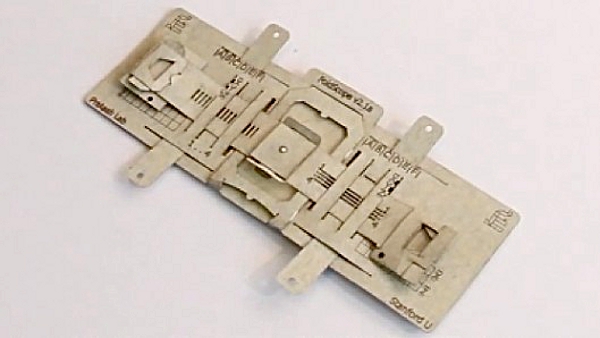
These are actual Foldscope slides:
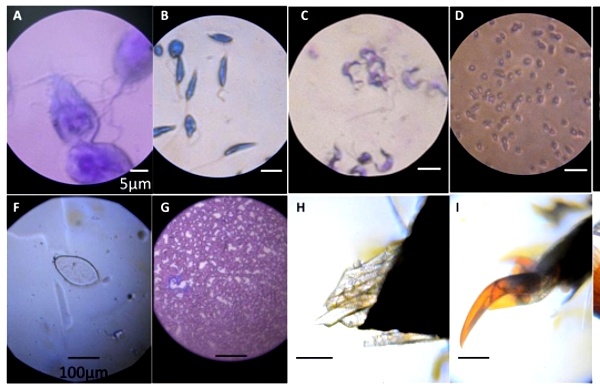
That puts things in perspective, doesn't it?
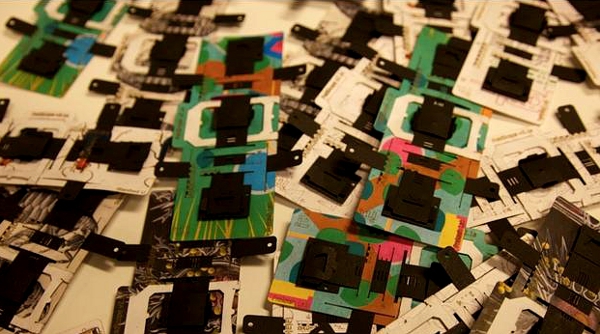
I saw this on the web this morning and I think it is just the thing to put the icing on our ancient-microscopy cake...
Foldscope

We are a research team at PrakashLab at Stanford University, focused on democratizing science by developing scientific tools that can scale up to match problems in global health and science education. Here we describe Foldscope, a new approach for mass manufacturing of optical microscopes that are printed-and-folded from a single flat sheet of paper, akin to Origami.
These are actual Foldscope slides:

That puts things in perspective, doesn't it?

edit on 25-3-2014 by Bybyots because: . : .
Skyfloating
reply to post by LUXUS
Just to reply to you directly and acknowledge that I can see the JAR. I apologize for my previous ignorance.
(...but still think its uncanny that the jar is made to look like a sperm with its squiggly tail and head)
The ancient Egyptians were given a legacy of teachings from the old world, they knew many things that today is forgotten, what is the human mind capable of when it is trained, can it see these things without a lenses, can the human mind enter the atom and observe its functioning?
As for the squiggly line, when you pour water out of a container from a height it naturally spirals out of the container as it falls to Earth, they obviously had observed this and noted it in their art.
I've really enjoyed this thread the last few days and I must say this has been some of the best cross-research I've seen on ATS and it's about an
image of a 3000 year old erection... Madness but they do say good things come in small packages (no offense to any pharaohs involved...)
If only more threads had such mutually benficial research and debate, hats off to the posters here, keep it up. One of my favourite threads yet.
If only more threads had such mutually benficial research and debate, hats off to the posters here, keep it up. One of my favourite threads yet.
reply to post by Bybyots
Interesting thing to point out. Thing is, if there was an ancient version of a microscope, would we recognize it as such? That foldscope has little or no resemblence to the traditional lab-bench microscope most people may be familiar with.
The ancients didn't have plastic... So the construction would have to utilize materials available to them at the time. Glass may have been available, but getting glass of optical quality as well as grinding and/or polishing would have been problematic. (Not that they couldn't overcome the problems with making such glass, but other easier solutions were available.)
I could imagine something like a piece of copper foil with holes poked in it, and having a pin-prick sized bead of water placed on the holes to act as a lens. Or perhaps something like loops of wire that suspended lenses extracted from the eyes of minnows? (In the early history of known microscopy, the glass lenses weren't easy to make and some people actually used fish eyes as a cheap alternative that provided good optical quality.)
If you're an archeologist and found a copper piece of foil and you didn't see it used in practice as a microscope (and without any ancient texts or inscriptions depicting its use), how would you discern it's parts from various other junk or jewelry?
As for the oldest known works on optics and lenses? Those would come from the Greeks, with writings from around the time of more well known scholars such as Archimedes. It means people around the Mediterranean back then definitely knew about this stuff for a good while, even if it's use wasn't considered all that common.
Would be neat if there's any substantial proof to back up such speculation, but it's plausible at least. Knowing what we know now, a form of microscope could be made with what was available to Egyptians of that era. The question remains, did they?
Interesting thing to point out. Thing is, if there was an ancient version of a microscope, would we recognize it as such? That foldscope has little or no resemblence to the traditional lab-bench microscope most people may be familiar with.
The ancients didn't have plastic... So the construction would have to utilize materials available to them at the time. Glass may have been available, but getting glass of optical quality as well as grinding and/or polishing would have been problematic. (Not that they couldn't overcome the problems with making such glass, but other easier solutions were available.)
I could imagine something like a piece of copper foil with holes poked in it, and having a pin-prick sized bead of water placed on the holes to act as a lens. Or perhaps something like loops of wire that suspended lenses extracted from the eyes of minnows? (In the early history of known microscopy, the glass lenses weren't easy to make and some people actually used fish eyes as a cheap alternative that provided good optical quality.)
If you're an archeologist and found a copper piece of foil and you didn't see it used in practice as a microscope (and without any ancient texts or inscriptions depicting its use), how would you discern it's parts from various other junk or jewelry?
As for the oldest known works on optics and lenses? Those would come from the Greeks, with writings from around the time of more well known scholars such as Archimedes. It means people around the Mediterranean back then definitely knew about this stuff for a good while, even if it's use wasn't considered all that common.
Would be neat if there's any substantial proof to back up such speculation, but it's plausible at least. Knowing what we know now, a form of microscope could be made with what was available to Egyptians of that era. The question remains, did they?
John Ernst Worrell Keely, 1894
A building, pyramidal in shape, two hundred feet high, one hundred feet at the base, and having at the apex a disc with a minute aperture in its center, and a triple combination of reflectors, which must concentrate upon one center which must be focalized upon the minute aperture in the disc, - the image being received at the base of the pyramid upon a white surface prepared to receive it, - would yield results beyond the dreams of the most sanguine astronomer of the present day. The distinctness of the image taken would be the most wonderful part of the phenomenon, and the size of the magnification would be limited only to the diameter of the base of the pyramid.
new topics
-
TLDR post about ATS and why I love it and hope we all stay together somewhere
General Chit Chat: 9 minutes ago -
Hate makes for strange bedfellows
US Political Madness: 2 hours ago -
Who guards the guards
US Political Madness: 4 hours ago -
Has Tesla manipulated data logs to cover up auto pilot crash?
Automotive Discussion: 6 hours ago -
whistleblower Captain Bill Uhouse on the Kingman UFO recovery
Aliens and UFOs: 11 hours ago
top topics
-
CIA botched its handling of sexual assault allegations, House intel report says
Breaking Alternative News: 16 hours ago, 11 flags -
whistleblower Captain Bill Uhouse on the Kingman UFO recovery
Aliens and UFOs: 11 hours ago, 10 flags -
Hate makes for strange bedfellows
US Political Madness: 2 hours ago, 9 flags -
Who guards the guards
US Political Madness: 4 hours ago, 8 flags -
1980s Arcade
General Chit Chat: 13 hours ago, 5 flags -
Teenager makes chess history becoming the youngest challenger for the world championship crown
Other Current Events: 15 hours ago, 4 flags -
Deadpool and Wolverine
Movies: 14 hours ago, 4 flags -
Has Tesla manipulated data logs to cover up auto pilot crash?
Automotive Discussion: 6 hours ago, 2 flags -
TLDR post about ATS and why I love it and hope we all stay together somewhere
General Chit Chat: 9 minutes ago, 0 flags
active topics
-
Hate makes for strange bedfellows
US Political Madness • 18 • : network dude -
Candidate TRUMP Now Has Crazy Judge JUAN MERCHAN After Him - The Stormy Daniels Hush-Money Case.
Political Conspiracies • 689 • : matafuchs -
SC Jack Smith is Using Subterfuge Tricks with Donald Trumps Upcoming Documents Trial.
Dissecting Disinformation • 102 • : Threadbarer -
Russia Ukraine Update Thread - part 3
World War Three • 5714 • : stu119 -
TLDR post about ATS and why I love it and hope we all stay together somewhere
General Chit Chat • 0 • : SideEyeEverything1 -
How ageing is" immune deficiency"
Medical Issues & Conspiracies • 27 • : RookQueen2 -
whistleblower Captain Bill Uhouse on the Kingman UFO recovery
Aliens and UFOs • 14 • : alldaylong -
"We're All Hamas" Heard at Columbia University Protests
Social Issues and Civil Unrest • 234 • : KrustyKrab -
IDF Intel Chief Resigns Over Hamas attack
Middle East Issues • 42 • : TheWoker -
Deadpool and Wolverine
Movies • 4 • : FlyersFan

